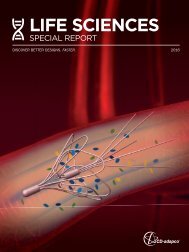Life science special report 161215 IY opt
You also want an ePaper? Increase the reach of your titles
YUMPU automatically turns print PDFs into web optimized ePapers that Google loves.
TABLETING AND COATING LIFE SCIENCES<br />
NUMERICAL SIMULATIONS FOR<br />
TABLETING AND COATING<br />
SABINE GOODWIN, OLEH BARAN & KRISTIAN DEBUS<br />
CD-adapco<br />
Solid dose tablet manufacturing<br />
processes often lack reliability and<br />
robustness as a result of errors in<br />
production and a shortfall in process<br />
control. Facing unprecedented economic<br />
pressures, pharmaceutical manufacturing<br />
companies are continuously looking to<br />
improve on the quality of their products<br />
and the productivity of their processes.<br />
Multi-physics numerical simulation is<br />
emerging as a game-changing technology<br />
to help step up effi ciency, enhance quality,<br />
and shorten time-to-market through<br />
virtual prototyping and <strong>opt</strong>imization.<br />
CHALLENGES OF SOLID DOSE<br />
TABLET MANUFACTURING<br />
Tableting (compression from a powder<br />
into a solid dose tablet) and tablet<br />
coating are two vitally important steps<br />
in the tablet manufacturing process<br />
that ultimately determine the weight,<br />
thickness, density, hardness and<br />
coating of the final solid dosage form.<br />
Variability in any of these attributes<br />
not only negatively impacts the release<br />
profile and therapeutic efficacy of the<br />
medicine, it alters the disintegration<br />
and dissolution properties of the<br />
tablet, leads to tablet defects and<br />
causes breakage during bulk packaging<br />
and transport. With the ad<strong>opt</strong>ion of<br />
novel manufacturing processes such<br />
as non-stop end-to-end processing,<br />
and the push to build quality and<br />
effi ciency into production, solid dose<br />
tablet manufacturers have a challenging<br />
road ahead of them because they<br />
must pinpoint the key factors and<br />
requirements that will lead to robust<br />
and repeatable processes, resulting<br />
in superior products.<br />
WHY NUMERICAL<br />
SIMULATIONS?<br />
Multi-physics Computational Fluid<br />
Dynamics (CFD) is a numerical method<br />
for predicting the coupled behavior of<br />
fl uid, gas and particulate fl ows including<br />
heat and mass transport.<br />
A signifi cant advantage of using<br />
FIGURE 1: STAR-CCM+ simulation with DEM showing a pharmaceutical powder packed<br />
and compressed inside a tablet die. Variations in color refl ect the non-uniformity of the<br />
granule distribution.<br />
numerical simulations is that it allows<br />
for the validation of a design or<br />
process before physical tests need<br />
to be carried out. For example, the<br />
development of a new tablet shape or<br />
coating material calls for performing<br />
an extensive number of costly and<br />
time-consuming experiments to<br />
avoid unexpected variations, identify<br />
unpredictable process parameters and<br />
address scale-up problems. Studying<br />
these effects through numerical<br />
simulations can greatly reduce time,<br />
material and development costs. In<br />
addition, numerical visualization tools<br />
offer a wealth of detailed information,<br />
not always readily available from<br />
experimental tests. This not only results<br />
in an increased level of insight into<br />
the details of what is going on inside<br />
the processes, it enables innovation.<br />
STAR-CCM+ PROVIDES<br />
THE SOLUTIONS<br />
With its automated polyhedral meshing<br />
technology and comprehensive range<br />
of physics models, STAR-CCM+ is a<br />
complete multi-disciplinary simulation<br />
toolkit to tackle a wide range of<br />
applications in the pharmaceutical<br />
industry. One capability in STAR-CCM+<br />
that is particularly well-suited for the<br />
simulation of tablet manufacturing<br />
processes is Discrete Element Modeling<br />
(DEM), fully coupled with numerical<br />
fl ow simulations and delivered in<br />
a single software environment.<br />
Tableting and coating involve a large<br />
number of discrete particles that<br />
interact with each other and the fl uids<br />
surrounding them. DEM accurately<br />
tracks these interactions and models<br />
contact forces and energy transfer due<br />
to collision and heat transfer between<br />
particles and fl uids. The DEM capability<br />
in STAR-CCM+ can predict dense particle<br />
One capability that is<br />
particularly well-suited<br />
for the simulation of tablet<br />
manufacturing processes<br />
is DEM, fully coupled<br />
with numerical flow<br />
simulations and delivered<br />
in a single software<br />
environment.<br />
SPECIAL REPORT<br />
23



